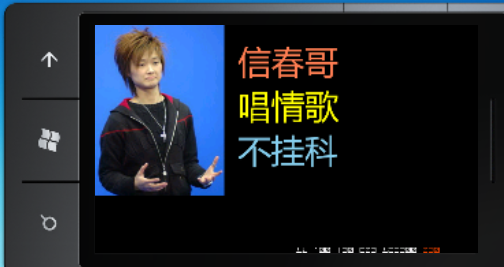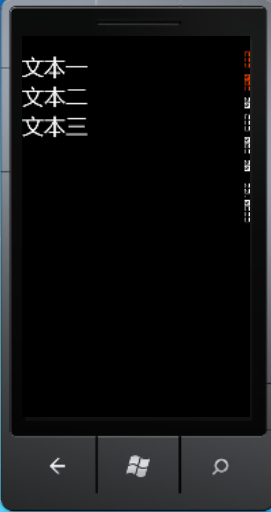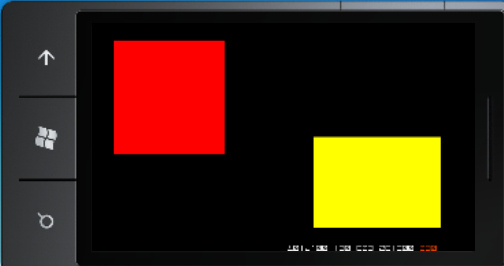Windows Phone開發(6):處理屏幕方向的改變
阿新 • • 發佈:2017-05-10
cati sources mon stack mar ber XML break pac
俺們都知道,智能手機可以通過旋轉手機來改變屏幕的顯示方向,更多的時候,對於屏幕方向的改變,我們要做出相應的處理,例如,當手機屏幕方向從縱向變為橫向時,可能要重新排列頁面上的控件以適應顯示區域的變化。
前面我們討論過,Silverlight for Windows Phone的頁面布局有三個常用的布局控件,那麽,當屏幕方向改變後,我們所做的對布局的更改基礎上是基於這幾個容器進行的操作。 本文我將通過三個示例來分別說明。 開始之前,先說一下PhoneApplicationPage類的OrientationChanged事件,該事件就是當屏幕的方向改變之後發生,我們從事件參數OrientationChangedEventArgs類的實例的Orientation屬性中獲取當前屏幕的方向,即改變後的方向,比如,原來屏幕是縱向,現在我把手機屏幕改為橫向,則Orientation屬性獲取到的方向就是橫向的,呵呵,當然也包括從哪個方向旋轉過來的,這裏只是舉例而已。要使頁面支持旋轉,要把PhoneApplicationPage的SupportedOrientations屬性改為PortraitOrLandscape,然後可以通過定義OrientationChanged事件來處理布局。形如:
- <phone:PhoneApplicationPage
- ..............
- SupportedOrientations="PortraitOrLandscape"
- Orientation="Portrait"
- OrientationChanged="PhoneApplicationPage_OrientationChanged">
一、Grid控件的處理。
- <phone:PhoneApplicationPage
- x:Class="Sample_PageDir.Page1"
- xmlns="http://schemas.microsoft.com/winfx/2006/xaml/presentation"
- xmlns:x="http://schemas.microsoft.com/winfx/2006/xaml"
- xmlns:phone="clr-namespace:Microsoft.Phone.Controls;assembly=Microsoft.Phone"
- xmlns:shell="clr-namespace:Microsoft.Phone.Shell;assembly=Microsoft.Phone"
- xmlns:d="http://schemas.microsoft.com/expression/blend/2008"
- xmlns:mc="http://schemas.openxmlformats.org/markup-compatibility/2006"
- FontFamily="{StaticResource PhoneFontFamilyNormal}"
- FontSize="{StaticResource PhoneFontSizeNormal}"
- Foreground="{StaticResource PhoneForegroundBrush}"
- mc:Ignorable="d" d:DesignHeight="768" d:DesignWidth="480"
- shell:SystemTray.IsVisible="True"
- SupportedOrientations="PortraitOrLandscape"
- Orientation="Portrait"
- OrientationChanged="PhoneApplicationPage_OrientationChanged">
- <Grid x:Name="layoutRoot">
- <Grid.RowDefinitions>
- <RowDefinition Height="Auto" />
- <RowDefinition Height="Auto" />
- </Grid.RowDefinitions>
- <Grid.ColumnDefinitions>
- <ColumnDefinition Width="Auto" />
- <ColumnDefinition Width="Auto" />
- </Grid.ColumnDefinitions>
- <Image x:Name="img" Source="http://gubapic.eastmoney.com/member/e68/e681999/e68199920091216131540.jpg" Stretch="UniformToFill" Width="270" Grid.Row="0" Grid.Column="0" />
- <TextBlock x:Name="txtBlock"
- Grid.Row="1"
- Grid.Column="0"
- FontSize="70"
- Margin="28">
- <Run Foreground="Coral">信春哥</Run>
- <LineBreak/>
- <Run Foreground="Yellow">唱情歌</Run>
- <LineBreak/>
- <Run Foreground="SkyBlue">不掛科</Run>
- </TextBlock>
- </Grid>
- </phone:PhoneApplicationPage>
頁面主要有兩個控件,一個用於顯示圖片,一個用於顯示文本信息,通過事件處理代碼來相應改變兩個控件的布局。
- private void PhoneApplicationPage_OrientationChanged(object sender, OrientationChangedEventArgs e)
- {
- // 如果是橫向的
- if (e.Orientation == PageOrientation.Landscape ||
- e.Orientation == PageOrientation.LandscapeLeft ||
- e.Orientation == PageOrientation.LandscapeRight)
- {
- Grid.SetColumn(this.img, 0);
- Grid.SetRow(this.img, 0);
- Grid.SetRow(this.txtBlock, 0);
- Grid.SetColumn(this.txtBlock, 1);
- }
- // 如果是縱向
- else if (e.Orientation == PageOrientation.Portrait ||
- e.Orientation == PageOrientation.PortraitDown ||
- e.Orientation == PageOrientation.PortraitUp)
- {
- Grid.SetColumn(this.img, 0);
- Grid.SetRow(this.img, 0);
- Grid.SetRow(this.txtBlock, 1);
- Grid.SetColumn(this.txtBlock, 0);
- }
- else
- {
- Grid.SetColumn(this.img, 0);
- Grid.SetRow(this.img, 0);
- Grid.SetRow(this.txtBlock, 1);
- Grid.SetColumn(this.txtBlock, 0);
- }
- }
按F5運行程序,默認的屏幕方向是縱向的,如下圖所示:

好,現在,我們把屏幕旋轉一下,看看會怎麽樣。

二、StackPanel控件的處理。
- <phone:PhoneApplicationPage
- x:Class="Sample_PageDir.Page2"
- xmlns="http://schemas.microsoft.com/winfx/2006/xaml/presentation"
- xmlns:x="http://schemas.microsoft.com/winfx/2006/xaml"
- xmlns:phone="clr-namespace:Microsoft.Phone.Controls;assembly=Microsoft.Phone"
- xmlns:shell="clr-namespace:Microsoft.Phone.Shell;assembly=Microsoft.Phone"
- xmlns:d="http://schemas.microsoft.com/expression/blend/2008"
- xmlns:mc="http://schemas.openxmlformats.org/markup-compatibility/2006"
- FontFamily="{StaticResource PhoneFontFamilyNormal}"
- FontSize="{StaticResource PhoneFontSizeNormal}"
- Foreground="{StaticResource PhoneForegroundBrush}"
- SupportedOrientations="PortraitOrLandscape"
- OrientationChanged="PhoneApplicationPage_OrientationChanged"
- Orientation="Portrait"
- mc:Ignorable="d" d:DesignHeight="768" d:DesignWidth="480"
- shell:SystemTray.IsVisible="True">
- <phone:PhoneApplicationPage.Resources>
- <Style TargetType="TextBlock">
- <Setter Property="FontSize" Value="46"/>
- </Style>
- </phone:PhoneApplicationPage.Resources>
- <StackPanel x:Name="pl">
- <TextBlock Text="文本一"/>
- <TextBlock Text="文本二"/>
- <TextBlock Text="文本三"/>
- </StackPanel>
- </phone:PhoneApplicationPage>
後臺事件處理代碼。
- private void PhoneApplicationPage_OrientationChanged(object sender, OrientationChangedEventArgs e)
- {
- if (e.Orientation == PageOrientation.Landscape ||
- e.Orientation == PageOrientation.LandscapeLeft ||
- e.Orientation == PageOrientation.LandscapeRight)
- {
- this.pl.Orientation = System.Windows.Controls.Orientation.Horizontal;
- }
- else
- {
- this.pl.Orientation = System.Windows.Controls.Orientation.Vertical;
- }
- }
運行,默認方向是縱向。

把屏幕旋轉後。

三、Canvas控件的處理。
- <phone:PhoneApplicationPage
- x:Class="Sample_PageDir.Page3"
- xmlns="http://schemas.microsoft.com/winfx/2006/xaml/presentation"
- xmlns:x="http://schemas.microsoft.com/winfx/2006/xaml"
- xmlns:phone="clr-namespace:Microsoft.Phone.Controls;assembly=Microsoft.Phone"
- xmlns:shell="clr-namespace:Microsoft.Phone.Shell;assembly=Microsoft.Phone"
- xmlns:d="http://schemas.microsoft.com/expression/blend/2008"
- xmlns:mc="http://schemas.openxmlformats.org/markup-compatibility/2006"
- FontFamily="{StaticResource PhoneFontFamilyNormal}"
- FontSize="{StaticResource PhoneFontSizeNormal}"
- Foreground="{StaticResource PhoneForegroundBrush}"
- SupportedOrientations="PortraitOrLandscape"
- Orientation="Portrait"
- OrientationChanged="PhoneApplicationPage_OrientationChanged"
- mc:Ignorable="d" d:DesignHeight="768" d:DesignWidth="480"
- shell:SystemTray.IsVisible="True">
- <Canvas x:Name="cv">
- <Rectangle x:Name="rect1"
- Width="232"
- Height="238"
- Fill="Red"
- Canvas.Left="88"
- Canvas.Top="88"/>
- <Rectangle x:Name="rect2"
- Height="192"
- Width="275"
- Fill="Yellow"
- Canvas.Top="268"
- Canvas.Left="155"/>
- </Canvas>
- </phone:PhoneApplicationPage>
後臺代碼。後臺代碼。
- private void PhoneApplicationPage_OrientationChanged(object sender, OrientationChangedEventArgs e)
- {
- if (e.Orientation== PageOrientation.Landscape||e.Orientation== PageOrientation.LandscapeLeft||e.Orientation== PageOrientation.LandscapeRight)
- {
- Canvas.SetTop(this.rect1, 37);
- Canvas.SetLeft(this.rect1, 46);
- Canvas.SetTop(this.rect2, 240);
- Canvas.SetLeft(this.rect2, 462);
- }
- else
- {
- Canvas.SetTop(this.rect1, 88);
- Canvas.SetLeft(this.rect1, 88);
- Canvas.SetTop(this.rect2, 268);
- Canvas.SetLeft(this.rect2, 155);
- }
- }
看看效果。看看效果。
縱向。

橫向。

Windows Phone開發(6):處理屏幕方向的改變
